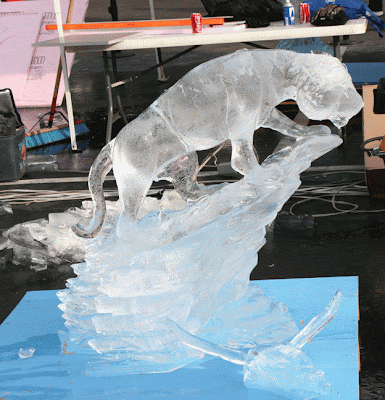I've always thought compost to be a pretty ordinary subject, maybe because I grew up with composting. Possibly other Baby Boomers did, also, I'm not sure, but back when
Organic Gardening was a new magazine, my mother was an enthusiastic subscriber. She liked the idea of taking otherwise wasted household vegetable scraps, potato peelings, coffee grounds, egg shells and anything else that wouldn't attract dogs or 'possoms, and turning them into rich, black soil for her houseplants.
Mom's method back then was to dig two holes in the raspberry patch, each about 2 ft. deep and as wide across. One was for new compost, the other was months old and nearly ready to use. Every day or two she'd take the kitchen waste and put it in the "new" hole and toss in a trowel full of soil and mix it around. Over the years she made a lot of soil using that simple method. (She learned, from this process, that almost anything organic would compost, except for maraschino cherries; they're made by soaking cherries in a solution of sodium metabisulfate, calcium chloride, citric acid, and back then, the addition of Red Dye numbers 1, 2, 3 and 4, all banned now for health reasons. After two years buried in the compost pile, the cherries were as red and firm as the day she had put them there).
But what is old is new and composting is fashionable again. The move toward recycling, coupled with the popularity of growing ones own food in the garden, has sparked lots of enthusiasm for the lowly compost pile.
 |
| Felder's truck garden. |
Here's what
Felder Rushing,
radio host and author of several garden books said recently (you may recall I posted photos of Felder's pickup truck last August, and his pickup truck garden which he grows on his trips across America and I was on his show last year):
"Composting isn't difficult. Here are the rules: pile up stuff. Let it rot."
It's really that simple although there are things you can do to facilitate the composting process working faster. For example, it's good to add "green" material to your compost, things like grass clippings after you mow. It's also helpful if you turn the compost over from time to time.

As you can see in this illustration by our friend, George Hudson, having two bins is helpful. As the compost piles up, the newest organic matter is always on top, so this guy would do well to start moving the top of his pile "next door" to the other bin. If he simply left it in a big pile like this, it would eventually rot away into compost, but it would take much, much longer. Giving the pile a turn every few weeks or months, helps speed up the process. Keeping the green material in rotation helps the decomposing matter "heat up" and that means everything breaks down faster. A good compost pile can turn leaves, grass clippings and vegetable scraps into rich, black soil in about 6 months. And the heating process that happens when fresh organic matter breaks down, will actually get hot enough to kill weed seeds. The more green matter you put in, the faster and better the compost pile works.

And yes, you can add leaves in the fall to your compost pile, provided you mix in some barnyard manure, or grass clippings or other green matter. Just a pile of leaves will pack down, stay dry and may not compost for a year or more without help. Oak and sycamore leaves are harder to compost than maple, ash, dogwood, etc. And if you're adding wood chips, the compost pile will require more green material.
Here are some successful compost methods I've seen lately. The first one is simply a long bin in the back yard of a very upscale house in Dallas. This is an easy method because the homeowner simply moves some already composted material over to the new pile every time he adds more leaves, grass clippings or kitchen waste.
 |
| Finished compost is on the left. To the left you can see a pile of kitchen scraps and broken up shrub clippings from the garden. |
And look at the one, below, at the Stonewall School garden project in Dallas. They combine wood chips with theirs and probably use a small garden tractor to turn the soil over, mixing finished compost with lawnmower grass clippings to break down the wood chips.
And the one, below, is in the garden of the famous and amazing
Herbfarm Restaurant in Woodinville, WA. Theirs looks efficient for making compost fast.
 |
| Notice this method uses 3 bins: new material, working compost and the finished product. |
The late Madalene Hill had this built in her gardens at Festival Hill a few years ago to demonstrate what materials will compost and what won't. It's a good measure of what to use and what not to put in your compost bin.
In case you can't read the tombstones: Leaves compost in 1-3 months, paper takes 3-5 months; paper milk cartons (shredded) 5 months; cigarette butts 10-20 years. Plastic bags take 50-80 years; aluminum foil 80-100 years and styrofoam never decomposes (neither do plastic water bottles).
So there are several choices for composting. The advantages are many: saving space in landfills, saving the cost of having someone haul away kitchen scraps and leaves; recycling materials that turn in to useful soil for your garden. And it can be as simple or as complex as you want it to be.
Like Felder says,
Pile up some stuff and let it rot. That's the basic idea of composting.
Thanks to our very talented friend, George Hudson, for the use of his always humorous illustrations.
Compost happens, just pile up stuff and let it rot.









































